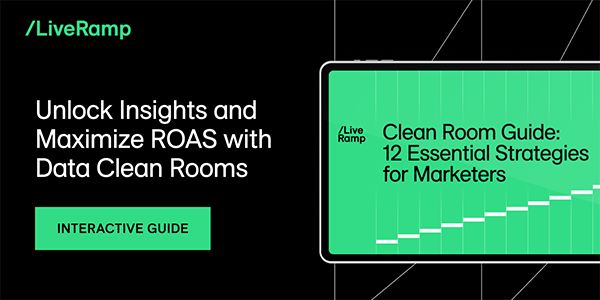The last five years saw our industry’s conventional models of ad targeting and measurement evaporate with the regulatory and cultural shift toward privacy. But out of these ashes, the advance of clean room architecture is enabling a deeper level of measurement and insights, which is moving us toward something much better than ever before.
Next-gen clean room platforms are starting to standardize use cases and legal terms with templates that make it easier and faster for agencies, brands and publishers to collaborate and derive value from their data – without requiring major data science firepower. This standardization is reinforcing the trust at the core of clean room architecture, bringing more players into the game and creating valuable new models for data collaboration and monetization.
Clean rooms aren’t the way back – they’re the path forward
The “golden age” of digital advertising in the early 2000s was far from perfect. We had clear signals for sales credit within a publisher environment, but piecing those signals together across publisher silos – or across multi-device or multi-channel journeys – made it difficult to truly understand reach and frequency.
Clean rooms offer something fundamentally better. Because clean rooms can be configured in alignment with each party’s privacy requirements, the vital signals we came to depend on can now be collaborated between parties responsibly. The ability for each party to hold and control its own data also significantly enhances the quality of the data itself, since each party can monitor and manage the fidelity of its data in real time.
Moreover, clean rooms bridge conventional silos of measurement data. Brands can bring together impression data from most publishers they work with – and conversion data from third-party retailers and commerce media partners.
Bringing standardization to clean room use cases and contracts
LiveRamp and a few other ad tech leaders have been working to advance clean room architecture for the better part of a decade. We’re seeing how early clean room adopters often have to trudge through the mud to get to the potential. It shouldn’t be that hard. It shouldn’t be that slow. And it shouldn’t require a whole team of data engineers.
Today, top clean room platforms are doing away with most of this pain. Brands and publishers don’t need major data science firepower (which most don’t have in-house dedicated to media) to write queries.
Instead, templatized use cases make the entire experience intuitive for anyone – like an “easy button” for sophisticated data collaboration, walking you through each step and telling you what data you need to put in. Want to measure reach, frequency or sales outcomes? Click the button. Measure against preconfigured audiences – or submit your own.
Templatization also opens a shortcut around the time and money spent on the typical endless contract negotiations needed to account for virtually endless possibilities of a blank-slate clean room. When you have standardized ways of working within the clean rooms, you can also standardize the legal terms. Pick the preconfigured use case and quickly review the preset contract to match.
Making data collaboration more collaborative
For the typical brand working with many publishers, templatized uses cases make getting insights faster, repeatable and scalable. Brands can standardize their analytics and measurement program across all publishers without having to rewrite queries or contracts from scratch each time.
This standardization also opens the doors to more advanced use cases in clean rooms. Brands can use data from many publishers in a single clean room, allowing for deduplication and cross-publisher measurement. Brands can harmonize measurement of campaigns that run across multiple publishers, and they can more quickly access and act on media performance metrics to refine their media-buying strategies. For example, a brand can maximize reach, gain more precise frequency analysis and make last-touch attribution more reliable, all of which optimize marketing performance.
Thanks to standardized use cases and contracts, the data owner – publishers in this case – can give brands this more expansive access to data while maintaining rigorous standards and controls over how that data is used.
LiveRamp is helping to pioneer this new kind of data collaboration, starting with measurement. Clean room collaboration allows brands to better understand how they’re engaging with a specific audience across and within publishers, recognizing gaps and opportunities, what’s working and what’s not and how to optimize.
A tremendous new frontier in commerce media
Next-gen clean room architecture is also unlocking new types of insights in the rapidly expanding world of commerce media.
Until now, brands were limited to using a commerce media partner’s consumer insights within that specific commerce media platform. But the clean rooms create a new capability for advertisers to take those ultra-rich targeting insights and apply them across a much broader range of premium publisher inventory – while still getting reliable proof-of-performance data.
For example, a retail media network could overlap its first-party consumer data with third-party publishers’ inventory and impression data. Then, a CPG could create a hyper-specific audience for one of its products: “I want high-income moms who are buying diapers once a month at Target – and I want it to go to Meta, TikTok and Snap,” for example. Those publishers can then share ad exposure data back into the clean room, and the retail media network can clearly connect ad exposures to consumer actions, showing the brand what worked and what didn’t.
We’re heading for a new golden age of digital advertising
The expansion of data collaboration within commerce media is a powerful example of responsible use cases that benefit all stakeholders.
Yet the most profound impact of clean rooms is much simpler: The rapid democratization of simple, standardized tools and methodologies is bringing reliable measurement back and ushering in a new golden age of digital advertising.
As more brands and publishers adopt clean rooms, we will see brands more successfully targeting the right consumers with the right messages to drive more sales and higher ROI. We will see publishers and commerce media partners finding new and better ways to monetize their data. And we will see consumers getting the only thing they really want out of this whole game – ads that are truly relevant and genuinely helpful.
















